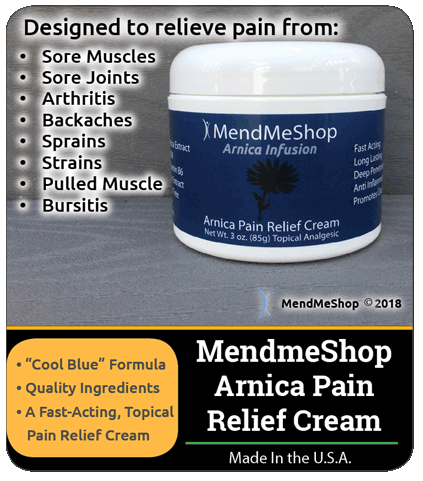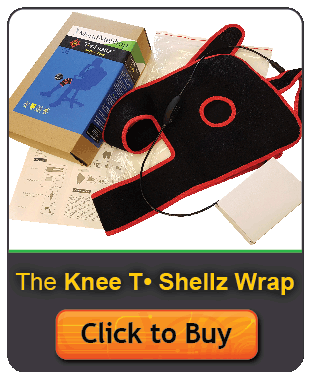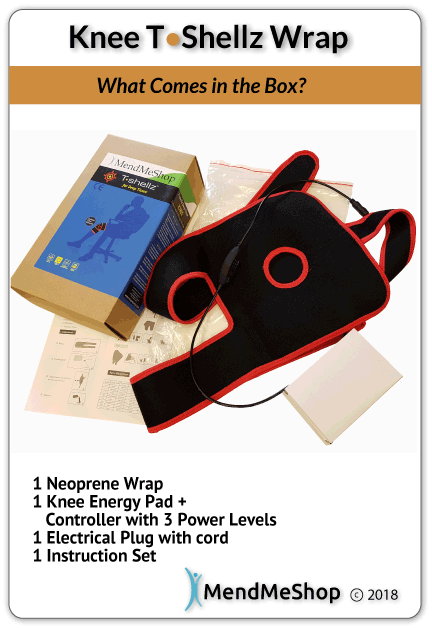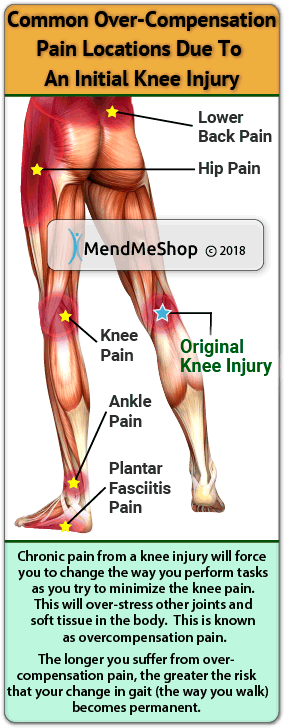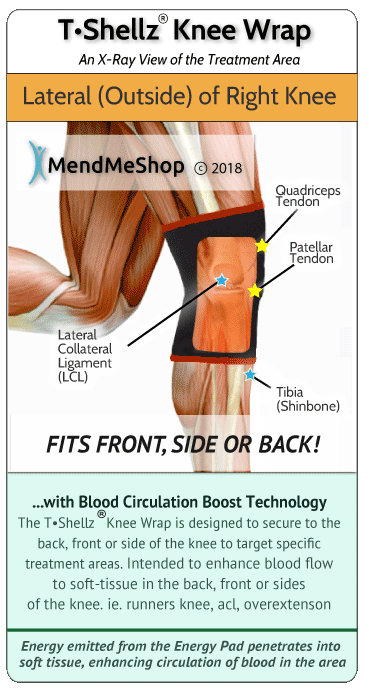|
| An Advanced Look Into Causation, & Possible Conservative Treatment Options for The MeniscusA Large Number of our Clients Have:Stages of Healing for a Torn MeniscusStep 1: Get a Diagnosis & Use Cold Therapy to Reduce InflammationBlood supply to your injured meniscus is critical to healing, as your body uses blood flow to heal. The blood supply to a meniscus tear is determined by 2 factors:
Tears located on the inner rim of meniscus are known as white zone tears and tears located on the outer rim are known as red zone tears. White zone meniscus tears receive little to no blood flow, whereas red zone tears receive good blood flow. Basically, this means that the ability of your meniscus tear to heal itself reduces as the tear location moves inward. The first thing to do is speak with your doctor. Only your doctor can give you a proper diagnosis and from this, determine a course of proper treatment. Once your doctor determines the information about the tear - tear type, tear size, tear location and tear pattern, they will know whether you need surgery on your meniscus tear. If surgery is not recommended, your doctor will almost always advise conservative treatment options - conservative treatment options for a medial meniscus tear typically means rest, icing the injury, elevating the injury, reducing load on the injury (crutches or brace) and taking anti-inflammatory medication. If possible, avoiding surgery is typically the best option. However in some some cases meniscal repair or even a meniscectomy is advised - or in some cases necessary. Surgical removal of a meniscus (a procedure called a meniscectomy) may be necessary if the meniscus is worn down too much and/or is damaged beyond repair. Artificial meniscal implants might be used following a meniscectomy but the success rate of meniscal implants is not always great (reference: boneandjoint.org.uk).  Inflammation is the body's natural response to a soft tissue injury and is a normal part of the healing process - helping to reduce tissue infection in the early stages of injury. Swelling, pain, heat sensation, redness, and loss of function are the main symptoms experienced and it is your bodys way of telling you there is something wrong. For certain soft tissue injuries of the knee, there may be no other option than surgery. As an example, if you have a full tear of a ligament, tendon, muscle or meniscus- attachment surgery will be required to sew them back together; in some cases, graft surgery (moving soft tissue from one site to another) is utilized when reattachment success is improbable. Step 2: Enhance Blood Flow to Injured Soft TissueThe meniscus is a unique, rubber-like, fibrous cartilage and is considered to be dense soft tissue. As stated earlier, the meniscus receives very limited blood flow and the inner portion of the meniscus receives little to no blood flow at all; this is the precise reason why damage to a meniscus can take a long time to heal - and in some cases, not heal at all. Knowing that enhanced blood flow is a critical necessity for accelerated healing of soft tissue, the challenge becomes this: How do you effectively increase blood flow to dense soft tissue (the meniscus) that normally receives very little blood flow?
It is through the blood the body carries the oxygen, nutrients and water that injured tissues rely on for recovery.. It is well known that increased blood flow helps your body accelerate the healing process. When you have a meniscus injury, there is reduced blood flow to the injury site. Inflammation and reduced movement (lack of activity or on-going immobility) will reduce the flow of blood - and if you think about it, this makes sense. Moving the joint(s) where your meniscus it torn is very painful, so it is very common for sufferers to have significantly reduced mobility; over time, this leads to atrophy - a shortening of muscles, tendons and ligaments of the joint. As the meniscus heals, you run a high risk of straining your muscles and tendons as they have become shortened due to lack of use - leading to more soft tissue injures and possibly putting you into a chronic soft tissue injury cycle. This is why the Knee TShellz Wrap® is such an important tool. The whole purpose of the wrap is to accelerate blood flow to soft tissue in the treatment area. The end result; you relax the blood vessels within soft tissues of the treatment area. The vessels will naturally expand and allow for more blood flow to reach the very tissues you are trying to heal. In addition, this process will help clear the area of toxins and excess fluid build up, thereby reducing inflammation. Step 3: Recognize That Healing is a Process With dedication, the right tools, and the right information - you may be able to achieve your goal of a sustainable recovery. A combination approach of cold compression, TShellz Wrap® treatments, and functional movements is intended to make it happen much more quickly. In our experience, soft tissue repair rates via conservative home treatment methods using a dedicated, comprehensive approach have surprised many of our clients, but will differ from person to person. In nearly all cases, however, it is very important to stop whatever you were doing that created the injury in the first place (ie. running, jumping or any activity that involves significant load on the meniscus). If you have questions, we welcome you to call our office toll-free at 1-866-237-9608 (Continental US), or Internationally at +1-705-532-1671. What is a Meniscus?Terms Used in this Section:
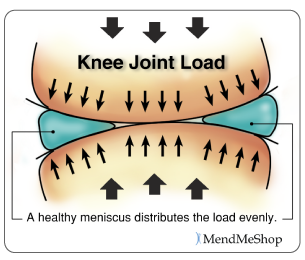 The menisci play a very important role in the proper working of the knee - they serve as cushions to decrease the stress caused by load-bearing and shock forces on the knees. They work like shock absorbers, supporting the load by compressing and spreading the weight evenly within the knee. Even while walking, the pressure put on the knee joints can be 2 - 4 times your own body weight; when you run these forces increase up to 6 - 8 times your body weight and are even higher when landing from a jump. By increasing the area of contact inside the joint by nearly 3 times, the menisci reduce the load significantly (dispersing between 30 and 55% of the load). By increasing the area of contact inside the joint by nearly 3 times, the menisci reduce the load significantly (dispersing between 30 and 55% of the load).This is an extremely important point to understand about the meniscus - if you lose your meniscus, you not only lose the meniscus shock absorber, but you also lose the "expanded area" of absorption. This means that this same load that was once handled by the meniscus is now borne mostly by articular cartilage over a much smaller contact area. Articular cartilage is what is on the ends of your bones that meet in the knee joint, and without the meniscus, your articular cartilage is almost 100% guaranteed to wear and break down (termed "osteoarthritis of the knee") as it is not capable of handling large loads over such a small contact area. As weight is applied to a meniscus, it becomes compressed and is forced to extend out from between the femur and tibia; it is much like what happens when you press down a rubber ball - it squishes out on the sides. However, the circular design of the menisci provides circumference tension (referred to as 'Hoop Stress') to resist this extension and provide stability as the load compresses. If the meniscus is torn at the peripheral rim, circumference tension is compromised and the meniscus loses its ability to transfer the load and the joint begins to suffer. In fact, if part of the peripheral is removed or the tear extends to the periphery, the load on the knee joint may increase by up to 350% causing stress and pain. However, if the tear remains on the interior without disrupting the periphery of the meniscus, the meniscus is still able to disperse the load without stress and pain. The menisci also assist with the proper movement (arthrokinematic) of the femur and tibia during flexion and extension. They help stabilize the knees when in motion, reduce friction within the joint, and lubricate and protect the articular cartilage surrounding the tips of the bones from damage due to wear and tear. Medial Meniscus and Lateral MeniscusThe soft tissue structure in the knee includes 2 menisci, the medial meniscus (located on the inside of the knee) and the lateral meniscus (located on the outside of the knee). Menisci are crescent-shaped pads of fibrocartilage that sit on the end of the tibia bone (tibial condyles) and form a concave surface for the rounded ends of the femur bone (femoral condyles) to rest on. They cover approximately 2/3 of the tibia surface and are thicker on the outside and thinner on the inside appearing triangular in cross section. The 2 menisci fill the space between the leg bones and cushion the femur so it doesn't slide off or rub against the tibia. Torn and damaged meniscus injuries are common knee injuries. The menisci, named the lateral meniscus and the medial meniscus are two tough pieces of cartilage that rest between the upper leg bone and the shin bone. Combined, these 2 menisci bear all of your body weight when you are standing and because of the incredible stress put on the menisci combined with low blood flow, healing can take a long time - especially without utilizing conservative treatment options on a daily basis. 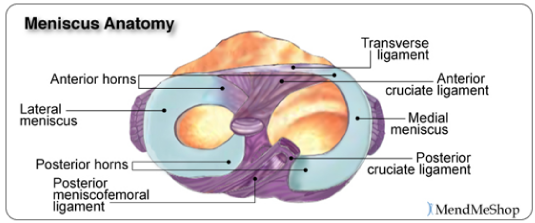 Blood flow to knee menisci comes from the inferior genicular artery. This artery supplies blood to the perimeniscal plexus which provides oxygen and nutrients to the synovial and capsular tissues around the menisci and within the knee joint. The coronary ligaments attached to the meniscus, transport the blood from the perimeniscal plexus (network of blood vessels) into the peripheral of the menisci. The anterior and posterior horns of the menisci also receive a good amount of blood as they are covered by a vascular synovium. The interior part of the meniscus is avascular, having NO direct blood supply. Tears in this region will typically require surgical intervention.
So I Think I Have a Knee Meniscus Injury - What Should I Do?If you suspect you may have a torn meniscus or some other form of meniscus injury, go consult your physician. Only your physician can truly diagnose if you are experiencing a meniscus injury, and from this, determine a course of proper treatment. After seeking medical advice, your physician may recommend surgery or a course of conservative treatment options. There are many factors that are considered in such a decision, most of which are outlined on our web-page Do I Need Meniscus Surgery? How Long to Recover from a Torn Meniscus?This is a difficult question to answer as healing time will depend on so many factors! Some meniscus tears will not heal on their own without surgery, especially if the tear is located in the inner portion of the meniscus where there is little to no blood flow. If the injury or tear is on the outer peripheral of the meniscus (where there is a relatively good blood supply) - healing time will be shorter than if the injury is in the central part of the meniscus. The outer one-third of the lateral and medial menisci are termed as "vascular", meaning there is an abundance of blood vessels that allow some blood to flow in the area. The central part of each meniscus has fewer blood vessels and the inner third does not contain any. As a result, a tear on the outer peripheral of the meniscus can heal faster than one on the inner portion. It is important to deal with meniscus tears fast as atrophy (reduced range of motion), strains and secondary injuries due to overcompensation will proliferate very quickly. Meniscus Injury healing time will differ for everyone but it is safe to say that cartilage generally has a slow healing rate due to low blood flow. The healing times for meniscus injuries will span months in more favourable cases (small tears near the outside periphery) and will span years in less favourable cases (large tears in the inner and central portions of the meniscus or sometimes not at all unless surgery is undertaken. Pre-Surgery & Post-SurgeryIf surgery is undertaken, you will find we have effective home rehab solutions for post-surgery recovery. You can read more about effective options for pre/post surgery here. Why is Fast Healing Important for Meniscus Tears?Once you experience a meniscus tear, you will find recovery time is lengthy, requiring a reduction in activity for a long period of time to allow the meniscus to heal. This is why many chronic (long term) sufferers start experiencing muscle atrophy and range of motion issues in both knees - your knees are much less active due to the injury as typically every time you use your knee, you will experience pain. The immobile joints will lose more and more flexibility as unused muscles shorten over time (atrophy), leaving you more prone to secondary issues such as knee strains and tendinitis. This is why it is important to heal your meniscus injury as quickly as possible - you need to avoid the vicious cycle of decreased Range of Motion and re-injury that will occur with chronic (long term) meniscus tears. 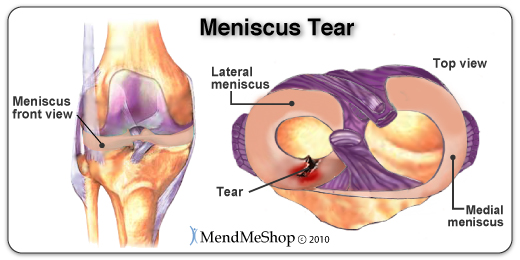 A Torn Meniscus Should Not Normally Persist as Long As It Often Does for ManyRecovery from even minor meniscus tears can take a very long time, especially when less effective, traditional treatment methods are used. This is simply because typical treatments either focus on the masking of pain or are too inconsistent to provide sustainable improvement. Here are 4 main reasons why Meniscus Tears can take far longer to heal than they should: 1: People Tend To Focus Too Much On Cold TreatmentsWe see it all the time - people for weeks and even months only focus on using cold. Doing too much cold will actually inhibit the recovery because you are starving the injured tissues of the blood flow they need to repair and rebuild the collagen. Cold restricts the vessels - reducing the blood flow to the tissues that truly need it most. Cold treatments should be more focused on in the earliest stages of an injury with much less focus in the mid and latter stages.The truth is, there will always some mild inflammation associated with tissue injuries. However, some of that inflammation will remain UNTIL you begin to focus on healing the soft tissue (muscle). Once this begins to heal, the inflammation will then subside more permanently - not just temporarily like with cold treatments. As an analogy, think of a home with a leaky roof. You can place a bucket on the floor of the attic whenever it rains - and this will help temporarily, but does it truly address the situation? Obviously the answer is no. Not until you focus on repairing the structural issues with the roof - will the problem be actually solved. The same concept applies to injured soft tissue - you need to focus on reinforcing growth of flexible, strong tissue. To do this, you need more blood flow reaching them, not less. 2: Injections Can Cause Harm If You Are Not CarefulThis can be VERY helpful in alleviating pain and in many cases, pain relief alone can make a huge difference. However, some people get a false sense that their injury is healed because they are not experiencing the pain they once did. Some individuals even engage in activities they should not be doing because they "no longer feel pain". Once the effects wear off, people often find their knee troubles persist . This of course, results in a prolonged recovery. Be very careful about your activity after the injection because there is little, if any, pain feedback to tell you that you're overdoing it. Merely masking the pain can be very helpful temporarily, but it is not a solution; it is just a temporary fix. 3: Visits to Physio (PT) Help - We Always Recommend It - But It Can Be Costly And InconvenientWhile we tout the benefits of PT and believe it to be integral for recovery from soft tissue injuries, the problem is that people only attend sessions a few times a week. To truly provide a long term solution to combat atrophy and an inactive knee joint, you need to be receiving multiple treatments on a daily basis... Not just any type of treatments, but ones that focus on strengthening and improving tissue flexibility in the joint. Treatments for soft tissue injuries are cumulative in nature...meaning the more the treatments are administered, the faster the benefits can be experienced. Who these days has time to visit a therapist on a daily basis? Not only is your time limited, but the cost of daily physical therapy sessions is out of reach for most people. Therefore, the focus needs to be on adding treatment options that can be done frequently, from the comfort of your own home (and even the workplace if the opportunity presents itself). We will discuss these options later on down the page. 4: Torn Meniscus Sufferers Continue to Aggravate & Re-Injure Their KneeIt goes without saying that anyone suffering from a meniscus injury should want to minimize their chance of worsening the injury, or re-injuring it once it has started to get better. Obviously, a worsening injury will delay the healing process, but what's worse is that every re-injury and additional healing cycle increases the amount of time that your joint is immobilized. Time is not kind to an immobilized joint - you lose strength in the joint but worse than that, you lose the range of motion in your joint via atrophy (your flexible tendons, muscles and ligaments slowly shrink, decreasing joint elasticity). The more time that goes by with an immobile knee, the more likely you will wind up with a chronic knee problem. Basically it means that your knee will not perform as well as it once did and it becomes more prone to injury again later on. Minimizing the time spent with an immobile knee joint should be an obvious goal, as a meniscus tear will typically limit your ability to go about your daily routine. Meniscus Tears Are Painful, Persistent & Can Lead to Other Conditions and InjuriesEvery time we use our knee where there is a meniscus injury, tendons and muscle tissue move; when they disturb the injury, every movement hurts. With injured soft tissue, pain happens - sometimes a LOT of pain, so we try not to move it. So, when doing something we need to use our knee for (climbing stairs, getting up from the sofa, getting in a car, walking to the mailbox), we start to use the other knee more. A couple days later (after purposefully avoiding movement of your bad knee), the pain has gone down (as well as the swelling) and this is where the trouble begins! The pain disappeared with the swelling but we still aren't fully healed! Not knowing this, we start using our knee again and then the pain and inflammation show up again like it did before - all because the injury wasn't fully healed in the first place. Eventually, we use the other knee more and more, over a lengthy period of time. This is why the other joints start to hurt - they are being overused and taking the load that your bad knee once did. Soon, aches and pain can become commonplace elsewhere in the body - all as a result of the original meniscus injury and the body's instinctive nature to "protect" it - all because the injury wasn't fully healed in the first place! We continually re-injure ourselves through our daily activities and now we are dealing with long term chronic injuries due to atrophy and overcompensation. 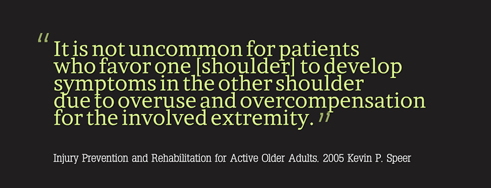 Muscle imbalances result, placing tension on bone and softer tissues - leading to a misalignment within the lower body. The extra stress on the opposite side of the body will also result in weakness and fatigue of soft tissue - increasing the chances they can eventually be injured or gradually degenerate. This is a textbook example of how you get an overcompensation injury. In some cases, physical therapists warn that overcompensation can be very dangerous as it has the capability of affecting gait or alignment on a permanent basis. An injury to a meniscus in the knee can easily lead to straining in other areas, making an overall recovery hard to initiate. For example, a small meniscus tear in right knee can often lead to over-straining of the left knee and even hip. Most commonly, the injury occurs on the dominant side, so the risk of straining the other (weaker) side increases. The longer the injury (and corresponding pain) persists, the greater the chance that you will sustain more strain from overcompensation, eventually leading to issues in those areas as well. To minimize potential secondary injuries, know that it is important to deal with your original injury quickly and completely. Truly, meniscus pain can trigger a vicious overcompensation and re-injury cycle - which is why it is absolutely critical to focus on methods that improve and strengthen the injured meniscus in a timely manner - this means getting to the doctor and if conservative treatment options are prescribed, make sure you listen and do these treatments as frequently as they advise. The faster you truly heal, the less chance you have of sinking into a downward spiral of re-injury, scar tissue growth, atrophy and overcompensation injuries. The Good News: the Body uses Blood to Repair ItselfBefore we go further, it is important to understand that your body designed to self heal. Your blood flow carries oxygen and much needed nutrients to injured tissue in the body while also flushing away toxins and waste at the same time. When you have a knee injury, however, you are resting and generally your knees are not active. Why? Well, if you are walking (or even worse - running or jumping) around with a meniscus injury, you greatly increase the risk of increasing the severity of the injury. If there has been some healing, you could re-injure you knee all over again. Blood Flow - the natural healing process in your body needs assistance for a meniscal injury because blood flow is greatly restricted in these areas - especially when your knees are not moving. If there has been some healing, you could re-injure yourself if your joint is not immobile. Blood Flow (the natural healing process in your body) needs assistance for such injuries because blood flow is greatly restricted when you are immobile. When treating soft tissue injuries such as a meniscus tear, an effective therapy will increase blood flow to the injured area while the joint is immobile. The increased blood flow will accelerate the body's own ability to heal itself. Being a Pro Athlete Has AdvantagesA pro athlete with a knee injury has the luxury of being attended to by athletic trainers and physical therapists. The objective of the therapists is to get the athlete healed as fast as possible. They use a combination of therapeutic tools, exercise and stretching to stimulate blood flow to the injury on a constant basis. Even once they return to the sport, they continue this therapy to heal any recurring tendon or ligament damage before it can build into something big. For professional athletes, having the right tools means all the difference. Often, a professional athlete can be back in competition in weeks while regular patients with the same injuries can take months to heal. By utilizing methods and tools that professional athletes use, we can all recover from our knee injuries much more quickly. Promoting blood flow around an injured area to help the body heal itself is a concept that has been utilized for centuries. Oxygen and nutrients, carried within the blood, are critical for the body to heal itself. Without proper blood flow, recovering from an injury or condition will be delayed...sometimes for a very long period of time. Even though the concept is simple, improving blood flow can be difficult. When the injury is knee related, the challenges are even greater. Traditional methods require your knee to move to promote blood flow, but that same motion that promotes blood flow can also lead to making your pain and condition worse.
Most people we deal with tell us these scenarios have happened to them many times in the past. The real challenge is how to promote blood flow to the knee without causing further injury This goal is further complicated by the fact the knee is involved in the majority of the physical movements we perform each day. Hip, upper leg and knee pain can be interconnected and are often experienced in conjunction with one another. Many of the muscles that surround the knee are connected to muscles in the hip and foot; because of this, knee pain can be very debilitating from the hip down. An injury to the knee can easily lead to straining in other areas, making an overall recovery hard to initiate. For example, a pain in the right knee can often lead to over-straining of the left knee. The longer the injury (and corresponding pain) persists, the greater the chance that you will sustain more strain from overcompensation, eventually leading to issues in those areas as well. To minimize the potential for secondary injuries, know that it is important to deal with your knee injury quickly and completely. Okay, So I Have A Meniscus Injury ...What Should I Do Now?If you suspect you may have a meniscus tear, the first thing to do is consult your physician; only your physician can give you a proper diagnosis and from this, determine a course of proper treatment. After seeking medical advice, your physician will determine the degree of severity; in some cases surgery may be advised in which case a conservative treatment protocol would be recommended after your skin heals up from surgery. In many cases, depending on the severity and location of the tear, your physician will recommend conservative treatment options. A general outline of our conservative home treatment recommendations follow.. Stage 1: If the meniscus injury is very recent - use a good quality cold pack and Arnica Pain Relief Cream. If the injury has been going on for awhile and inflammation is reduced, then skip to Stage 2 below.If you are experiencing pain and swelling in the very early stages of the injury (first 48 to 72 hours), the first step in a conservative treatment protocol would be to focus on reducing the discomfort by applying a Cold Compress or Ice Pack to the knee along with a high quality pain relief cream such as our Arnica Infusion Cream. Not only will you use your Cold Compress or Ice Pack for the first 48 to 72 hours after the injury, but you should also use it during other stages of the healing process. Some examples include...
Having a Cold Compress or Ice Pack available at home to use if and when the need arises is helpful. Many of you already do so. However, too many people over-focus on cold therapy while ignoring the most critical aspect to healing - nourishing the injured tissues with a healthy supply of blood flow needed to repair and rebuild the injured tissues. This leads to the most important recommendation for Stage 2... Stage 2: Focus on Increasing Blood Flow To The Knee - This is How the Body's Healing Process is StimulatedEven though the concept is simple, improving blood flow to soft tissue can be difficult; in some cases - such as the inner third portion of the meniscus there is NO blood flow and in such cases, you will most likely require surgery for repair. When talking about the vascular portion of the meniscus (the outer two thirds), challenges are still substantial as this portion of the meniscus receives very little blood flow. Traditional methods require your knee to move to promote blood flow (exercise/stretches), but that same motion that promotes blood flow can at times lead to making your pain and condition worse.
Most people we deal with tell us these scenarios have happened to them many times in the past. Perhaps it has already happened to you. Promoting blood flow within a soft tissue injury to help the body heal itself is a concept that has been utilized for centuries. This is where the focus has to be if you are seeking long-term improvement. Oxygen and nutrients, carried within the blood, are critical for the body to heal itself. Without proper blood flow, recovering from an injury or condition will be delayed...sometimes for a very long period of time. The real challenge is how do you promote blood flow to the deep soft tissue (meniscus, tendons, ligaments) in your knee without causing further injury? Heat energy generated by the TShellz Wraps® operate by increasing blood flow in our injured soft tissue. This means ligaments, muscles, and tendons. The objective of the TShellz Wrap® is to increase blood flow in these targeted areas, resulting in relaxation of the vessel walls. The vessels then gently expand, allowing for more nutrient rich blood flow along with extra oxygen to reach the damaged tissues. Plus, the enhanced blood flow helps in flushing waste and fluid build-up from the injury site - further enhancing the ability of the body to heal. More blood now begins to flow effectively to tissue in the body; this tissue uses the added blood flow to heal as it is through the blood that the body carries the oxygen, nutrients and water needed for proper and long-term healing. Now, on to recommendation number two in the journey to heal your meniscus... The Knee TShellz Wrap® - A Healthy Knee For The Long TermThe best option we came across in our research to accomplish effective blood flow to soft tissue in the knee at home is the Knee TShellz Wrap®. Use of this device results in an increase of blood flow to the treatment area - all in a non-invasive manner. Have you seen what happens when you add water to a flower wilted from drought? In essence, your meniscus injury is much like a "wilted" flower; your body wants to heal its injury, but needs lots of nutrients to do it. Blood brings new life to your tissue by delivering healing nutrients and oxygen that are vital for their growth and survival. In addition, the blood carries away toxins and waste - cleaning the area and healing it faster. Without a good supply of blood, your meniscus simply won't heal properly. Using a TShellz Wrap® will not expose you to the risk of causing further harm to soft tissue like you can when using rigorous exercise. The TShellz Wrap® accomplishes the goal of indirectly stimulating blood circulation without the need for intensive exercise and as such reduces your risk of re-injury. The TShellz Wrap® - Accelerated Blood Flow for Your Knee Soft TissueThe intention of a Knee TShellz Wrap® is to ease pain by blood vessel dilation, decrease stiffness by elongation of soft tissue, improve blood circulation, and boost metabolism and enzyme activity. In stimulating localized blood flow to damaged soft tissue, you provide needed oxygen, nutrients and water to grow strong healthy collagen. In addition, you will experience a clearing of toxins and excess fluid build up from the injury site. Over the intermediate term, this helps to reduce incidents of swelling as trapped fluids will be whisked away - reducing pressure on blood vessels. Using the TShellz Wrap® is truly a unique experience. Within moments of applying a treatment to your knee, you can feel the healing sensation due to the increase in blood flow within the area. During a treatment, and for quite some time after you finish, the treated area will feel relaxed and less painful. It's a very soothing sensation and extremely effective. Who Should Use the TShellz Wrap®We recommend the use of a TShellz Wrap®:
Increased Blood Circulation = Increased Healing Rate TShellz Wraps® contain a unique, flexible Carbon Fiber Energy Pad which is flexible and will shape to conform to your body. This Energy Pad emits a uniform wave of perfectly safe energy over its entire surface. This energy is absorbed by soft tissue in your knee and opens blood vessels, resulting in an increase in blood flow. Increased blood circulation is what your body needs to accelerate the healing of soft tissue and this is why we recommend the Knee TShellz Wrap®. Consistent Treatments = Consistent And Long Term HealthWhat Else Makes the TShellz Wrap® So Special?We believe the use of TShellz Wraps® for boosting blood flow to soft tissue in the knee is one of the most under-utilized home treatment options available on the market today. We have client after client that have tried many options out there and have been amazed at how effective and fast the TShellz Wrap treatment can relieve pain and increase blood flow in soft tissue. We can promise that you will receive a product that is designed to be safe and does what it is supposed to do...quickly relieve pain and aid stimulating blood flow to soft tissue. The unit plugs into a standard wall outlet to get its power. The nice thing about the power supply is that the same unit can be used in North America and overseas as well. It has the capability to operate between 110v and 230v. It has a special signal controller that can be set for 3 different power levels of application (3=High, 2=Medium, 1=Low). The cord is long so you can sit or lie comfortably and watch TV, read or surf the net while you're using it. Treatments are max 30 minutes in duration and the device can be worn over clothing. This allows you to use the device at work, at home, or really anywhere you have access to an electrical outlet. A Recap of the Benefits of the TShellz Wrap®..
When Should I Use My TShellz Wrap During the Day?The most common question we receive from individuals prior to purchasing is - how many times a day should I be using my knee wrap and when should I be using them? While treatment plans will differ for each individual and their specific injury, there are general guidelines that should be adhered to.
The Knee TShellz Wrap® would then be used:
Stage 3 - In Between Treatments With TShellz Wrap®, Apply Our New Fast Acting Pain Relief Cream Called ARNICA INFUSIONDealing with aches and pains affecting the leg, knee, hamstring or hip? If so, then applying the Arnica Infusion to any of these targeted areas will bring about fast relief from the pain and sore tissues. Simply apply a small amount of cream to the body and moments later, you will experience a soothing and comforting sensation over the area. Arnica Infusion is specially designed to relieve pain due to sore muscles and joints associated with arthritis, knee pain, sprains, strains, and bruises. No matter if you are dealing with an acute injury, chronic pain, or a general "flare-up" - you will experience fast relief from pain and inflammation. This is a product that many of our current MendMeShop customers asked us to develop. So we focused our time and resources over the past few years and came up, with we believe, will be one of more effective, fast acting, topical pain relief creams on the market. You are likely familiar with some of the standard topical agents on the market as most of our customers use them. The are mass marketed and even found in most department stores now. Well, we are here to say that Arnica Infusion goes many steps beyond what they offer. Made in the USA at an FDA registered manufacturing facility, you can be assured that Arnica Infusion is both safe and effective. We only source top grade ingredients while implementing strict quality control checks during every step of the production process. Expect the same high quality that MendMeShop customers have been accustomed to since we started the company in 2005. The "Cool Blue" formula is the perfect balance between the smooth application of a cream and the effective absorbing factor of a gel. It is not too thick and not too thin - just the right texture. Best of all, it feels very nice on the skin! Each application of Arnica Infusion feels so comforting and soothing, we are certain it will become an item you will not want to live without. Arnica Infusion IngredientsThe Arnica Infusion formula is based on a combination of scientific research and the use of high quality ingredients. The properties within the formula were chosen for their pain relief, anti-inflammatory, and soothing qualities. The acting ingredients within the formula include ones many of us are familiar with; along with ones that have not received a lot of publicity (only in research circles). Extensive testing resulted in a blending of ingredients that provides the most synergistic of benefits. The notable ingredients in the Arnica Infusion formula include:
Extensive quality control procedures during the manufacturing process ensure the ingredients and final product are both safe and effective. We would not stake our reputation on anything but the best. When Do I Apply the Arnica Infusion?While At WorkApply Arnica Infusion at work to help reduce acute discomfort associated with overuse of muscles and joints. No matter if you are in a physical demanding job or work within an office environment, you will be placing stress on different parts of the body and aches and pains will result. Before Or After Work, Sports, & ActivityIf you suffer from a sprained ligament, pulled muscle, strained tendon, or even bruising - apply Arnica Infusion for quick relief of the pain. Chronic Pain SufferingApplication of Arnica Infusion can be done up to a maximum of 4 times per day on a consistent basis to help bring about relief from various pains and aches. In-between Treatments With the TShellz Wraps®Follow up your TShellz Wrap® treatments and Cold treatments with an application of Arnica Infusion. Combine the pain relieving benefits of Arnica Infusion along with the healing benefits of the wraps to make your recovery go much more smoothly. Do not apply Arnica Infusion within a 2 hour time-span before a TShellz Wrap® treatment. Whether you decide to use the Arnica Infusion in conjunction with the T-Shell and other treatments - or if you decide to use the cream as a stand-alone product - you will not be disappointed with the results. We guarantee it. Stage 4: Passive Knee Stretching... |
        |







